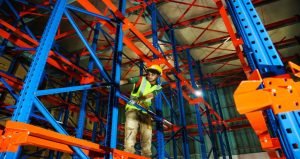Warehouse Compliance Becomes More Complicated, And Associating With A Specialist Only Helps To Manage A Cost-Effective, Durable & Compliant Warehouse.

With the changes in regulations, warehouse compliance becomes more complicated, and associating with a specialist only helps to manage a cost-effective, durable & compliant warehouse.
To stock inventory for the majority of warehouse managers, it was ordinary to purchase a “quick-shipped” standard storage rack from the rack manufacturers’. Nowadays this became very complex because the safety & storage management regulations became stricter and more specialized.
Now, industrial racking systems are usually considered a structural-like component, so it has to go through the different state, federal, and local regulations also the buyers’ compliance requirements as well. These ordinances are persistently evolving, also considering the seismic standards and other safety issues these became more complicated than before – and the warehouse managers who are unfamiliar with them may fail the warehouse audit, and become noncompliant with the ordinance. Which will make the situation more complicated.
In this situation, the warehouse managers must keep close contact with expert guidance for compliant design from an industry professional whenever developing the foundation, racking, or warehouse infrastructure. For any unusual stress, loading, function, or other non-standard factors occur. And should act in a preventive manner by taking contingency strategies.
Sequential quick-ship warehouse pallet racking systems are advantageous but should handle carefully non-flammable, non-hazardous products stored inside buildings in lower seismic regions.
Generally, with high-speed racks, there is an utmost pallet load limit that the racking system can grasp and the highest bay load limit that the warehouse floor and the racking system can handle. So, any industrial racking system requires a qualified design professional’s review for avoiding any unexpected situations.
Even when the high-speed industrial racking system is adequate for a warehouse. Still, there may be a requirement for expert advice for any special circumstances – for instance, if the racking system installation occurs in a warehouse with a sloping floor. Despite greater warehouse complexity and evolving regulations and other compliance issues, understanding a few key features and best uses of racking will help warehouse managers to keep their facilities safe, cost-effectively, productive, and compliant.
The key features understanding also included environmental concerns and seismic standards for structural rack-supported buildings. Engineered systems such as elevated platforms, pick modules, and Automated Storage and Retrieval Systems (AS/RS) also have their own engineering factors like means-of-access requirements, means-of-egress, and travel distance, as well as guarding and safety protection.
Environmental and Seismic Issues
According to the International Building Code, storage racking systems are thought of as building-like structures and are reflected in the Rack Manufacturer’s Standard. Racking systems or industrial racking structures are required to be planned to the local seismic requirements just like a building and other infrastructure. Responsible industrial warehouse managers will have to follow this accepted sizer for seismic design.

Seismic management compliance factors are now obligatory demand from the industry stakeholders, buyers & other compliance authorities. And with better structural performance in the course of an earthquake occurrence, these standards will continue to develop and will be putting more demand on the industrial racking design.
If you are considering outdoor racking then the rack-supported industrial structures must also be planned to estimate the rain, wind, and other loads.
For such an uncommon environmental situation, it is necessary to take consult an expert about incorporating essential safety factors into the industrial racking system design.
Industrial Racking Systems include AS/RS Structures and Pick Modules.
By definition of an industrial racking system when any standard or non-standard racking system that requires particular design considerations, can incorporate safety equipment and a variety of rack types, that are actually applicable to warehouse storage management.
Industrial Safety
When it comes to safety, the racking system must be planned for any unusual loads, stresses, or functions placed on it. It must have to be compliant with applicable insurance and fire code requirements. For example, racking loaded with flammable items would require certain places to assure adequate fire detection, suppression, and containment,
Some of the most highly engineered racking systems actually involve elevated platforms, pick modules, and work platforms. In such designed racking systems, a number of major key factors must be considered also to ensure compliance, safety, and permitting.

In order to maintain fall protection and safe access, the positioning of
ladders, suitable stairs, and guarding should also be implemented all over the racking system design.
Because in such industrial racking systems design must consider allowing for safe drop zones, through an opening in the side railing to permit easy receiving, which should be properly designed too.
Warehouse Serviceability
Ensuring that the industrial racking system works as planned and that the employees working on an industrial racking structure feel comfortable is another contemplation.
Normally, this is indicated as serviceability. The term refers to how it has been designed with certain structural elements like elevated walkways that must allow the required support and solidity for cart use or walking without any unacceptable sway or bounce.
While such industrial racking systems need considerable advice from a design expert, AS/RS racking structures design – could be more than 100 feet tall and could bear loads of more than 100,000 lbs. per storage bay which is huge! – so this requires even more integration and planning.
Nowadays in warehouse management, the AS/RS systems are becoming progressively popular in larger warehouse management and huge store distribution centers, and massive RMG / Food / Trading companies for their capacity to supply high turnaround and very high-volume storage with the least labor.
In the AS/RS systems, there is huge interfacing between the racking and the equipment, as these racking systems use automated cranes and usually map each position on a coordinated flat surface via computer, the tolerances are a lot tighter.
As the machines stop at exact locations, and each opening has to be at the exact location. So, the racking system must be very stiff and the rack must be plumb and straight.
Quick-ship, High-Speed, or Engineered industrial Rack?
We must agree that installing quick-ship racking in the warehouse is suitable for many standard applications. Still, it’s unavoidable that more complex, much larger warehouse management today requires expert opinion from a design professional. This is the regular case when it is essential to coordinate with integrators as well as various safety and trade professionals under a deadline.

Problems often take place when warehouse managers think that it is
cheaper and quicker to purchase quick-ship racking when the application really calls for an engineered system.
So, when material flow, optimal storage, safety, and compliance is mandatory in warehouse storage management, efficient managers will take the support they need up front to avoid delays, retrofits, or costly surprises.
Industrial Racking System Frequently Asked Questions (FAQ)
What is industrial racking?
Answer: Industrial rack often refers to a material handling storage aid system designed to store materials on Skids (or “pallets”). There are many varieties in the racking system but most of the types of pallet racking systems are designed for multiplying your warehouse spaces, and organizing the storage of palletized stuff in horizontal rows with multiple levels are referred to as industrial racking systems.
What is a selective racking system?
Answer: When the term comes “selective” means the users/clients are free to select their required pallet load that synchronizes with the racking system within the same structure or spaces. Naturally, this selective racking system is commonly used and well accepted by users/clients as it fulfills their demands.
What are the differences between racking and shelving?
Answer: This is something that needs to be considered very carefully, because shelving refers to the activities of placing and delivering the items/goods from the storage, where the entire process is managed by a manual system, generally by hand. And now comes the automation process where mechanical equipment is used for the placement and retrieval of goods. This process will save your staffing cost, product damage, and timely handling. Considering your needs Master Racks introduces a wide variety of loading /unloading equipment. If you want to know more please Click here!
What are the benefits of Industrial Racking?
Answer: Below we mentioned other key benefits of Industrial Racking: Direct and easy access to each pallet, Flexible operation, Easy assembling feature, reconfiguring/re-slot is simple, Cost-Saving, Versatile uses, Compatible pallet with one another, Enhanced strength, etc.
Do You Want to Know the Best Industrial Racking Systems Provider in Bangladesh And Why Warehouse Management Is Important For Your Business?
Master Racks Limited! Here you will experience the Best Industrial Racking Systems Provider in Bangladesh. We are providing shelving, racking, steel racks, industrial racking, storage shelves, and complete warehouse racking system solutions.

